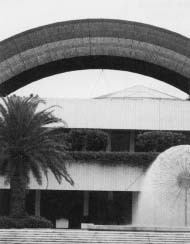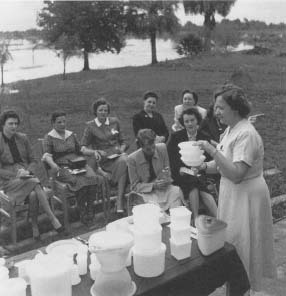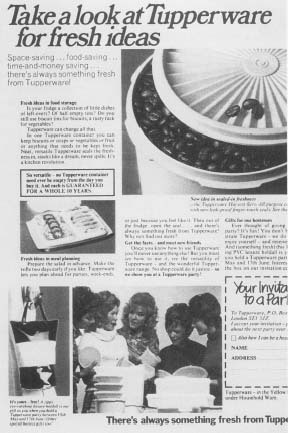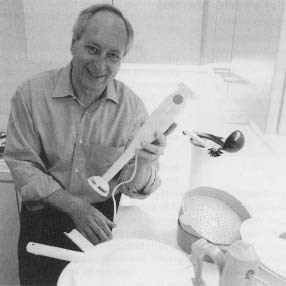Tupperware, Inc.
14901 South Orange Blossom Trail Orlando, FL 32837
(407) 826-50S0
www.tupperware.com

When Earl S. Tupper invented Poly-T, a new and better form of plastic, he opened the door for plastic to become a key material in household products. His Tupperware line, with its newly invented stay-fresh lid, also proved that goods made out of plastic could be useful, and attractive and lightweight. In addition, Tupper's company had a big impact on how household products and other items, especially for women, were sold. Its home party method of selling was imitated by later companies whose products, like Tupperware, needed to be demonstrated in order for consumers to understand their benefits.
All about Plastic
Earl Tupper formed his first company, the Earl S. Tupper Company, in 1938, after working in the plastics division of DuPont, a scientific research company, for one year. At first, the Tupper company developed industrial uses for plastic, working under contract to DuPont and later the U.S. government, for which it created gas masks and parts for the navy.
During World War II (1939-45), it was difficult to get raw materials for consumer products, so the company focused on its government contracts. After the war was over, however, Tupper began to concentrate on plastic consumer products such as sandwich picks and bathroom cups, or tumblers. The tumbler was the company's first consumer product; it was developed before World War II but not introduced until after the war ended.
Rather than selling his products through retail stores, Tupper sold them to corporations, which used them as premiums, free giveaways packaged with other products. For example, Tupper sold bathroom cups to the Tek company. The Tek company offered the cups for free to customers who purchased one of its toothbrushes.
The Invention of Poly-T
Meanwhile, Tupper was experimenting with polyethylene (pronounced pah-lee-eh-thuh-leen) slag, a smelly, greasy, and breakable material left behind after the process of refining oil. Commercial products made from this early form of plastic were limited. Tupper managed to develop a cleaner, translucent (see-through), and stronger plastic by purifying the slag. He also created a machine that could make shaped products from his improved plastic, which he called Poly-T, and developed an airtight lid that would keep products fresh when kept in containers made of Poly-T. The flagship product was a set of "nesting" bowls, which fit inside one another for stacking.
Tupperware at a Glance
- Employees: 6,800
- CEO: Rick Goings
- Subsidiaries: Dart Industries, Inc.; Premier Products, Inc.; Tupperware North America; BeautiControl Cosmetics, Inc.
- Major Competitors: Glad Products Co.; Rubbermaid Home Products
- Notable Products: The Wonderlier Bowl; Rock'N Serve unbreakable containers; OvenWorks microwaveable and bakeable containers; FridgeSmart storage containers
Tupper could see the value of his new product, which he called Tupperware, and his goal became to 'Tupperize" America. But, no matter how good his products were, Tupper had a tough time marketing them. He tried selling Tupperware through department and hardware stores, as well as in catalogs, but sales were low. The reason was that customers could not understand the benefits of the plastic and the airtight seal without an explanation or demonstration.
Timeline
- 1938:
- Earl Tupper forms the Earl S. Tupper Company to create industrial plastics.
- 1945:
- Tupper introduces its first consumer item, a bathroom tumbler.
- 1946:
- The company introduces its flagship product, a set of nesting bowls with airtight lids.
- 1948:
- Tupper meets Brownie Wise, a sales representative for Stanley Home Products.
- 1951:
- Brownie Wise becomes vice president of Tupperware Home Products.
- 1958:
- Wise is fired from Tupperware after many disagreements with Tupper.
- 1958:
- Tupper sells Tupperware to Rexall Corporation for $16 million and retires at age fifty one.
- 1983:
- Earl Tupper dies of a heart attack at age seventy-six.
- 1986:
- Tupperware becomes a subsidiary of Premark International.
- 1990:
- Tupperware hires Morison Cousins, designer of the Dixie Cup dispenser, as vice president of design.
- 1996:
- Tupperware becomes an independent company.
- 2000:
- Tupperware purchases BeautiControl, a firm that sells beauty products through home parties.
- 2001:
- Cousins dies of cancer at age sixty-six.
- 2002:
- Tupperware forms a partnership with Target Corporation.
Meeting Brownie Wise
Brownie Wise, a sales representative for Stanley Home Products, a wholesaler that distributed Tupperware as well as other products, had discovered that Tupperware could be sold to women once they understood how to use it. She had started to sell Tupperware at home parties where she demonstrated its qualities. These were also social gatherings that allowed women a rare opportunity to get out of the house.
By 1948, Tupper had heard about Wise's success and contacted her to find out more. Her ideas impressed him so much that he hired her and soon stopped selling Tupperware in retail sales. In 1947, Tupperware sales reached $5 million. Over the next three years, thanks to Wise and the nine thousand people who came on board to sell Tupperware products, sales increased fivefold to $25 million.
Wise was named vice president of Tupperware Home Products in 1951 and stayed with the company until 1958. Her home parties were the exclusive means of selling Tupperware products throughout most of the company's history and remained the primary method as of 2002. Wise's ability to sell products and motivate the sales force, called "hostesses," complemented Tupper's entrepreneurial spirit and inventiveness. Her upbeat attitude and successful career earned her the nickname "the Sunshine Cinderella" in the women's magazines of the 1950s.
Wise's idea brought women into the workforce yet allowed them to stay home with their families at the same time, which was important in the 1950s. Hostesses came from all walks of life, all ethnic backgrounds, and all across America. Some were divorced and single mothers like Wise herself.
When coming up with the famous Tupperware airtight lid, Earl Tupper was inspired by the lids used on paint cans. Essentially, the Tupperware lid is an upside down version of the lid on a metal can of house paint. When the Tupperware lid is used properly, it "burps" as it is sealed.
The Cousins Era
Earl Tupper sold Tupperware to the Rexall Corporation in 1958. Rexall changed its name to Dart Industries, which merged with Kraft Industries to become Dart and Kraft a decade later. In 1986, Dart and Kraft split and Tupperware became part of one of the new companies, Premark International. Tupperware became independent again in 1996. Throughout all of these changes, the company continued creating new storage products and selling them through home parties in the United States and, especially, in foreign countries, which became a key area of growth.

By the late 1980s, Tupperware had started to gain a reputation for making boring products. In 1990, it hired Morison Cousins, an established product designer, to make its household goods more modern and appealing to women of the 1990s. He brought in new designs and colors, some of which were shocking to company executives. He also made some practical improvements, such as designing easier-to-clean lids and rounded containers that made it easier to remove all the contents.
Cousins's designs may have shocked Tupperware executives and sales associates, but consumers liked them. In addition, they influenced other designers. Around 1992, young, hip home furnishings designers started creating products in colorful plastic, which they admitted were influenced by Tupperware.
In the early 2000s, Tupperware products were available in one hundred countries and a home party took place somewhere in the world every two seconds, according to the company's Web site. More than one million people were selling Tupperware products around the globe, and close to 85 percent of sales occurred outside the United States by 2002. Part of Tupperware's success outside the United States was due to the fact that it tailored products to each market. For example, the company sold storage products for kimonos and chopsticks in Japan; a storage system for a national dish, kimchee, in Korea; egg carts in Germany; and containers for tortillas in Latin America.
A Different Kind of Party
Tupperware parties evolved from previous door-to-door selling techniques, especially those used by the Fuller Brush Company, whose friendly and informative sales people, called Fuller Brush Men, gained women's trust. Tupperware home demonstrations included lots of games and other fun activities, as well as such giveaways as recipes. Tupperware saleswomen, called hostesses, received a commission of 35 percent of sales, and also received prizes, some of them valuable.
Company conventions in Florida, attended by hostesses from around the country, included prize giveaways, educational seminars, and information about new products. They also provided the chance for sales reps to mingle and exchange tips on how to sell more Tupperware.
Tupperware home parties were so successful that they influenced later companies, such as Mary Kay Cosmetics, which used the same types of sales force incentives and a similar home party system. Discovery Toys is another company that uses the at-home sales method. Parents are encouraged to buy children's toys by sitting down and playing with the products before purchasing them.
Targeting Twenty-First Century Women
As of the early 2000s, Tupperware remained one of the leading direct-sales operations (businesses selling directly to consumers instead of to retail stores) in the world, behind the cosmetics company Avon Products, Inc. (see entry) and the home products company Amway. Yet it faced challenges because the women who were both its main customers and its sales associates, had entered the workforce in great numbers and did not

One method of meeting these challenges was to hold lunchtime parties at daycare centers and offices, and to focus on themes such as saving time or sticking to diets. Tupperware

Tupperware expanded its presence in retail and on-line channels as well, hoping to increase awareness of the Tupperware brand (it was already ranked third among household goods, according to the trade magazine HFN) and to support its direct-sales team. At the end of 2000, more than four hundred mall kiosks showcased Tupperware products, while the company and its sales associates reached millions of new buyers over the Internet.
In 2002, the company forged a deal with Target Corporation (see entry), allowing the big chain to sell Tupperware in its stores, with the help of local Tupperware demonstrators. Tupperware CEO Rick Goings told The Los Angeles Times, "The Tupperware party isn't dead. This partnership enhances the Tupperware party."
In spite of all these new places where Tupperware could be found, 90 percent of sales were still made through home parties in the early 2000s. In fact, the higher profile of Tupperware increased U.S. sales and brought in younger women as customers and as sales associates.
At its headquarters in Orlando, Florida, Tupperware founded the Museum of Historic Food Containers. Its own products are found in the design collections of leading museums around the world, including the Museum of Modern Art in New York City and the Victoria and Albert Museum in Lon don, England.
In 2000, Tupperware expanded its direct-sales expertise into a new market by purchasing BeautiControl, Inc., a company that sold beauty and skin-care items through home parties. It also continued to develop new products. Its kitchen line grew to include storage products that can be baked, microwaved, or frozen. The company also markets non-kitchen products, including toys, furniture, and storage containers for sewing supplies, photographs, and ornaments. Tupperware has even introduced products with markings in Braille to make it easier for blind customers to use.
Comment about this article, ask questions, or add new information about this topic: